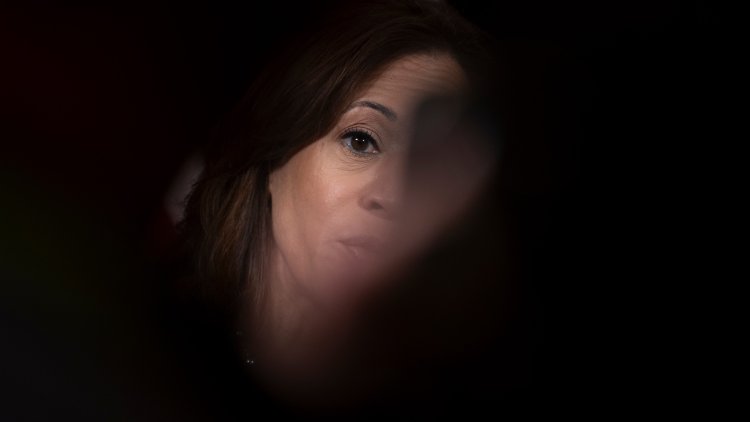Voters Wanted Lower Prices at Any Cost
Kamala Harris couldn’t outrun inflation.

Donald Trump is heading back to the White House. He has inflation to thank.
In poll after poll, focus group after focus group, Americans said the economy was bad—and the economy was bad because prices were too high. This was always going to be a problem for Kamala Harris. “Excess” inflation—defined as the cumulative growth of prices in one presidential term compared with the term preceding it—is highly predictive of electoral outcomes, according to the Northwestern economist Robert Gordon. It is a crucial part of how voters decide whether they are better off and want to stick with the incumbent. The measure strongly pointed to a Trump victory. Indeed, since the global post-pandemic inflation spike began, ruling parties around the world, on the left and the right, have been toppled.
Still, before this week, Democrats had good reasons to believe that they might be spared the inflation backlash. Households’ spending power improved more and faster in the United States than in other countries. On paper, families were doing better than they were before the pandemic, particularly at the low end of the income spectrum. Real wages—meaning wages adjusted for prices—jumped 13.2 percent for the lowest-income workers from 2019 to 2023; real wages for the highest-income workers climbed 4.4 percent.
[From the April 2024 issue: What would it take to convince Americans that the economy is fine?]
But voters do not make their decisions at the polls on the basis of price-adjusted time series. Nor do they seem to appreciate pundits and politicians telling them that their lived experience is somehow incorrect—that they are truly doing great; they just don’t know it.
Prices spiked more during the Biden administration than at any point since the early 1980s. In some categories, they remain unsustainably high. Home prices have jumped an astonishing 47 percent since early 2020. This has made homeowners wealthier on paper, but has priced millions of people out of the housing market. The situation with rented homes is no better. Costs are up more than 20 percent since COVID hit, and have doubled in some places. The number of cost-burdened renters is at an all-time high.
In response to inflation, the Federal Reserve raised interest rates. Inflation statistics do not include the cost of borrowing, but many Americans experienced higher rates—the supposed cure for higher prices—as making costs worse. Mortgage rates more than doubled from their pandemic-era level, adding insult to home-buying injury. The interest payment on a new-car loan has grown nearly as much. Credit-card APRs climbed to all-time highs, making many families’ buffer against month-to-month earnings and spending changes a costly one. If you include the cost of borrowing, inflation peaked at 18 percent, not 9 percent.
When asked over the past few years about their personal financial stressors, however, voters mostly haven’t focused on housing or auto loans. They overwhelmingly brought up everyday purchases, above all the price of groceries and fast food. Food inflation outpaced the overall rate for much of the Biden administration; in 2022, when inflation was 6.5 percent, the price of groceries grew by 11.8 percent. The price hikes cooled off in 2023, but prices themselves remained far higher than Americans were used to: Margarine, eggs, peanut butter, crackers, and bread all cost more than 40 percent more than they did just a few years ago. That everyday indignity seems to be what made inflation so salient for voters. The mental math families were tasked with felt excruciating. The sticker shock remained shocking.
[Annie Lowrey: The worst best economy ever]
The optimistic story for the Harris campaign was that, after a year of subdued price growth, the American people would have gotten used to higher bills and appreciated the earning power they gained from the tight labor market. Instead, anger at inflation lingered, even among tens of millions of working-class Americans who had gotten wealthier. This is not a purely economic story; it’s a psychological one too. People interpret wage gains as a product of their own effort and high costs as a policy problem that the president is supposed to solve. Going to the polls, voters still ranked the economy as their No. 1 issue, inflation as the No. 1 economic problem, and Trump as their preferred candidate to deal with it. In interviews, many voters told me they felt as if Democrats were gaslighting them by insisting that they were thriving.
Voters who expect Trump’s victory to herald a return to 2019 prices or relief from the cost-of-living crisis might be due for disappointment, though. Trump’s signature economic proposal of huge global tariffs would immediately raise the cost of household goods. And his promise to round up and deport millions of undocumented immigrants could create a labor shortage that would raise the cost of food, construction, home health care, and child care. He has offered no serious plan to address the deep, tangled problems that have made a middle-class life so unobtainable for so many Americans. Those problems preceded the Biden administration, and they will outlast the second Trump administration too.
What's Your Reaction?




















